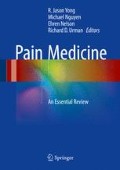Abstract
Hypnosis can be defined as an altered conscious state of focused attention which involves absorption, some dissociative elements, and an increased responsiveness to suggestion. Suggestions are verbal or non-verbal communications leading to subconscious changes in perception, mood, or behaviour. The main value of hypnosis as a technique in managing pain is to assist patients as a supplement to standard clinical care. The belief that the patient can do more than he or she thinks (and more than the doctor believes is possible) is likely to generate surprising therapeutic responses.
Access this chapter
Tax calculation will be finalised at checkout
Purchases are for personal use only
References
Elkins G, Jensen MP, Patterson DR. Hynotherapy for the management of chronic pain. Int J Clin Exp Hypn. 2007;55(3):275–87.
Hopkins MB, Jordan JM, Lundy RM. the effects of hypnosis and of imagery on bleeding time. Int J Clin Exp Hypn. 1991;39(3):134–9.
Ewin DM. Chapter 19. The use of hypnosis in the treatment of burns patients. In: Burrows D, Stanley RO, Bloom PB, editors. International handbook of clinical hypnosis. NewYork: Wiley; 2001. p. 273–84. ISBNs:0-471-97009-3 (Hardback) 0-470-84640-2(Electronic).
Lindfors P, Unge P, Arvidsson P, Nyhlin H, Bjomsson ES, Abrahamsson H. Effects of gut-directed hypnotherapy on IBS in different clinical settings-results from two randomized, controlled trials. Am J Gastroenterol. 2012;107(2):276–85.
Lee HH, Choi YY, Choi M-G. The efficacy of hypnotherapy in the treatment of irritable bowel syndrome: a systematic review and meta-analysis. J Neurogastroenterol Motil. 2014;20(2):152–62.
Moser G, Trägner S, Gajowniczek EE, Mikulits A, Michalski M, Kazemi-Shirazi L, Kulnigg-Dabsch S, Fuhrer M, Ponocny-Seliger E, Dejaco C, Miehsler W. Long-term success of GUT-directed group hypnosis for patients with refractory irritable bowel syndrome: a randomized controlled trial. Am J Gastroenterol. 2013;108(4):602–9.
Jensen M, Patterson DR. Hypnotic approaches for chronic pain: clinical implications of recent research findings. Am Psychol. 2014;69(2):167–77.
Dillworth T, Jensen MP. The role of suggestions in hypnosis for chronic pain: a review of the literature. Open Pain J. 2010;3(1):39–51.
Alladin A, Alibhai A. Cognitive hypnotherapy for depression: an empirical investigation. Int J Clin Exp Hypn. 2007;55(2):147–66.
Yapko M. Chapter 15. Hypnosis & depression. In: Handbook of clinical hypnosis. Washington, DC: APA; 2001.
Kirsch I, Montgomery G, Sapirstein G. Hypnosis as an adjunct to cognitive-behavioral psychotherapy: a meta-analysis. J Consult Clin Psychol. 1995;63(2):214–20.
Rainville P, Carrier B, Hofbauer RK, Bushnell MC, Duncan GH. Dissociation of sensory and affective dimensions of pain using hypnotic modulation. Pain. 1999;82(2):159–71.
Hofbauer RK, Rainville P, Duncan GH, Bushnell MC. Cortical representation of the sensory dimension of pain. J Neurophysiol. 2001;86(1):402–11.
Lackner JM, Lou Coad M, Mertz HR, Wack DS, Katz LA, Krasner SS, Firth R, Mahl TC, Lockwood AH. Cognitive therapy for irritable bowel syndrome is associated with reduced limbic activity, GI symptoms, and anxiety. Behav Res Ther. 2006;44(5):621–38.
Jensen KB, Kosek E, Wicksell R, Kemani M, Olsson G, Merle JV, Kadetoff D, Ingvar M. Cognitive behavioral therapy increases pain-evoked activation of the prefrontal cortex in patients with fibromyalgia. Pain. 2012;153:1495–503.
Grant JA, Courtemanche J, Rainville P. A non-elaborative mental stance and decoupling of executive and pain-related cortices predicts low pain sensitivity in Zen meditators. Pain. 2011;152:150–6.
Lazar SW, Kerr CE, Wasserman RH, Gray JR, Greve DN, Treadway MT, McGarvey M, Quinn BT, Dusek JA, Benson H, Rauch SL, Moore CI, Fischl B. Meditation experience is associated with increased cortical thickness. Neuroreport. 2005;16(17):1893–7.
Dumont L, Martin C, Broer I. Functional neuroimaging studies of hypnosis and meditation: a comparative perspective. J Mind-Body Regul. 2012;2(1):58–70.
Raz A, Fan J, Posner MI. Hypnotic suggestion reduces conflict in the human brain. Proc Natl Acad Sci U S A. 2005;102(28):9978–83.
Mrazek MD, Smallwood J, Schooler JW. Mindfulness and mind-wandering: finding convergence through opposing constructs. Emotion. 2012;12(3):442–8.
Kozasa EH, Sato JR, Lacedrda SS, Barreiros MA, Radvany J, Russell TA, Sanches LG, Mello LE, Amaro Jr E. Meditation training increases brain efficiency in an attention task. NeuroImage. 2012;59(1):745–9.
Doidge N. Hypnosis, neuroplasticity, and the plastic paradox. Am J Clin Hypn. 2015;57(3):349–54.
Waddell G. The back pain revolution. 2nd ed. Edinburgh: Churchill Livingstone; 2004.
Jensen MP. Hypnosis for chronic pain management: therapist guide. Oxford: Oxford University Press; 2011. p. 188.
Hammond DC. Handbook of hypnostic suggestions and metaphors. New York: WW Norton; 1990. p. 207, 293.
Yapko M. Hypnosis and treating depression: applications in clinical practice. New York: Routledge; 2013. p. 197.
Faymonville ME, Bejenke C, Hansen E. Hypnotic techniques. In: Cyna AM, Andrew MI, Tan SGM, Smith AF, editors. Handbook of communication in anaesthesia and critical care: a practical guide to exploring the art. Oxford: Oxford University Press; 2010.
Patterson DR. Clinical hypnosis for pain control. Washington, DC: American Psychological Association; 2010. p. 69.
Cyna AM, Tomkins D, Maddock T, Barker D. Brief hypnosis for severe needle phobia using switch—wire imagery in a 5‐year old. Pediatr Anesth. 2007;17(8):800–4.
Cyna A, Andrew MI, Tan SGM, Smith AF. Handbook of communication in anaesthesia and critical care: a practical guide to exploring the art. Oxford: Oxford University Press; 2010.
Krauss BS. “This may hurt”: predictions in procedural disclosure may do harm. BMJ. 2015;350:h649.
Author information
Authors and Affiliations
Corresponding author
Editor information
Editors and Affiliations
Rights and permissions
Copyright information
© 2017 Springer International Publishing Switzerland
About this chapter
Cite this chapter
Saltis, J., Tan, S.G.M., Cyna, A.M. (2017). Hypnosis for Pain Relief. In: Yong, R., Nguyen, M., Nelson, E., Urman, R. (eds) Pain Medicine. Springer, Cham. https://doi.org/10.1007/978-3-319-43133-8_152
Download citation
DOI: https://doi.org/10.1007/978-3-319-43133-8_152
Published:
Publisher Name: Springer, Cham
Print ISBN: 978-3-319-43131-4
Online ISBN: 978-3-319-43133-8
eBook Packages: MedicineMedicine (R0)

